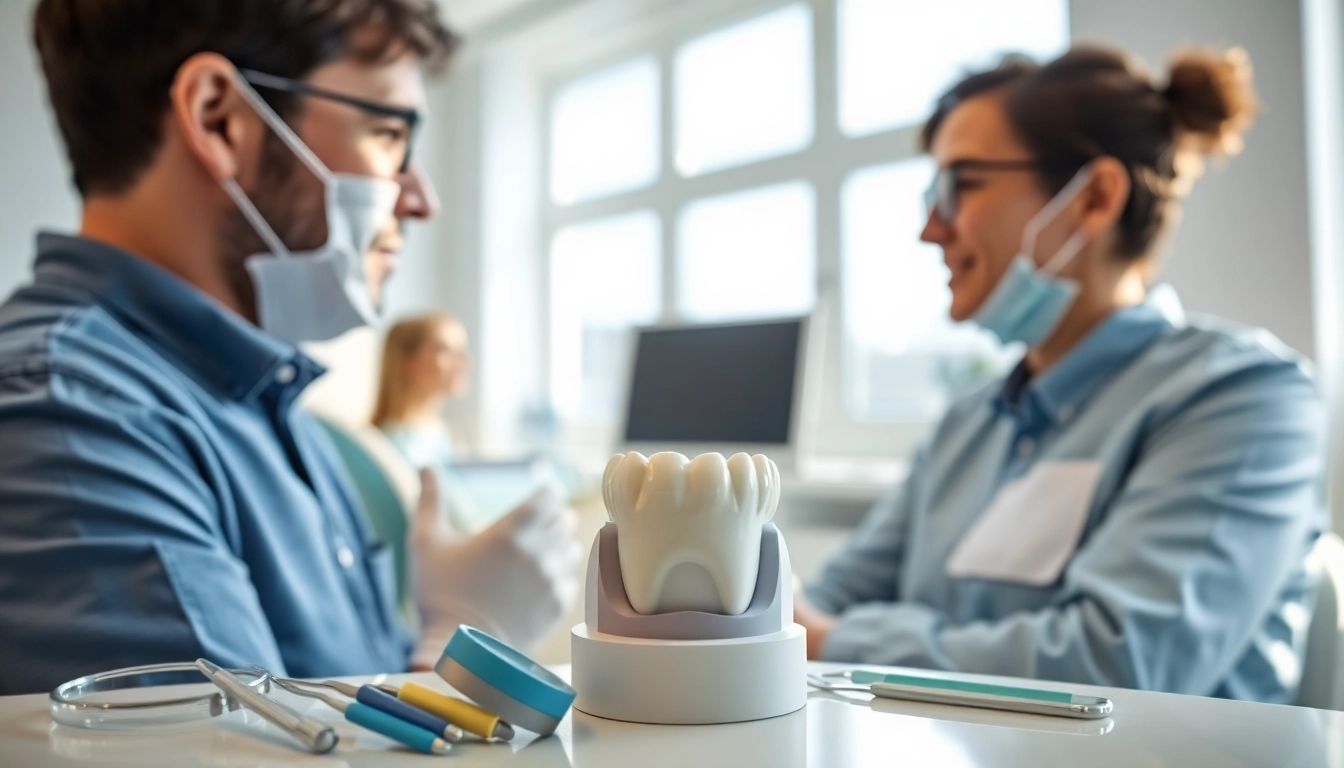Introduction to Dental Crowns
Dental health is an essential aspect of overall well-being, and one common solution for restoring damaged teeth is the use of crowns. A dental crown, often referred to as a cap, is a tooth-shaped covering that enhances the strength and appearance of a tooth that has been compromised due to decay, damage, or other dental concerns. This comprehensive article delves into the various facets of dental crowns, including their purposes, types, procedures, costs, maintenance, and answers to frequently asked questions.
What Are Crowns and Their Purpose?
Crowns serve multiple purposes in dental health care. Primarily, they act as protective coverings that encase a damaged or weakened tooth, providing strength, integrity, and aesthetic appeal. They can restore the shape, size, and overall function of the tooth, making them invaluable not only for cosmetic enhancement but also for maintaining proper bite alignment and chewing ability.
In addition to restoring individual teeth, crowns are also used in conjunction with dental implants to replace missing teeth, offering a permanent solution that mimics the appearance and functionality of natural teeth. Whether you require a crown following a root canal procedure or due to a cracked tooth, understanding their purpose is crucial for making informed decisions about your dental care.
Common Reasons for Getting Crowns
There are several common reasons why a dentist might recommend a dental crown, including:
- Restoration of Decayed Teeth: If a tooth is extensively decayed and cannot support a filling, a crown is used to restore its structure.
- Support for Weak Teeth: Teeth that have been weakened by extensive dental work or trauma may benefit from additional support provided by a crown.
- Completion of a Root Canal: After a root canal procedure, a crown is often placed to protect the tooth and restore its function.
- Enhancement of Appearance: Crowns are an excellent solution for improving the appearance of teeth that are discolored, chipped, or have irregular shapes.
- Replacement of Missing Teeth: Crowns can be utilized to cover dental implants, effectively replacing missing teeth and ensuring proper bite and alignment.
The Benefits of Dental Crowns
The benefits of dental crowns extend far beyond mere aesthetics. Here are some key advantages:
- Durability: Crowns are designed to last, with materials like porcelain, metal, and ceramic providing long-term solutions for tooth restoration.
- Improved Functionality: With a crown, patients can regain full function of their teeth, allowing for comfortable biting and chewing.
- Enhanced Aesthetic Appeal: Crowns can be color-matched to surrounding teeth for a seamless appearance, contributing to overall dental aesthetics.
- Protection: Crowns safeguard damaged teeth from further injury, which is essential for maintaining long-term dental health.
Types of Dental Crowns
Understanding the types of dental crowns available can help patients make informed decisions about their dental care. Here’s an exploration of the most common crown materials and their unique benefits.
Porcelain Crowns: Aesthetic Appeal
Porcelain crowns are popular for their ability to blend seamlessly with natural teeth. They are highly durable and resistant to staining, making them an ideal choice for visible areas in the mouth.
Porcelain crowns are especially favored for front teeth restorations due to their natural look and feel. These crowns are meticulously crafted to mimic the translucence and color of natural enamel.
One of the critical advantages of porcelain crowns is their biocompatibility, making them suitable for patients with metal allergies. While they can be slightly less durable than metal crowns, proper care can enhance their longevity significantly.
Metal Crowns: Durability and Strength
Metal crowns, often made of gold or other alloys, are renowned for their unparalleled durability. These crowns withstand significant biting and chewing forces, making them an excellent choice for back teeth where strength is critical.
Metal crowns are not as aesthetically pleasing as porcelain crowns, as they have a distinct metallic appearance, but they are often recommended when durability is prioritized over appearance.
Another advantage of metal crowns is their ability to wear down neighboring teeth less than other types of if they come into contact. This makes them a practical choice for areas subject to high chewing pressure.
Porcelain-Fused-to-Metal Crowns: Combining Strength with Beauty
Combining the best of both worlds, porcelain-fused-to-metal crowns offer the benefits of strength and aesthetics. The metal base provides durability, while the porcelain exterior allows for a natural appearance.
These crowns can be used in various applications, particularly for patients who want a stronger solution than porcelain alone but still desire a toothlike appearance.
While they can sometimes show a dark line at the gum line, advancements in technology have allowed for better color-matching and less noticeable results. Proper placement and maintenance can prolong the life of porcelain-fused-to-metal crowns significantly.
The Dental Crown Procedure
The journey to obtaining a dental crown involves a series of steps aimed at ensuring a successful and comfortable experience for the patient. Understanding this process can alleviate anxiety and prepare patients for what to expect.
Initial Consultation and Diagnosis
The first step in the dental crown procedure is scheduling a consultation with a dentist. During this visit, the dentist will conduct a thorough examination of the patient’s teeth and explore the need for a crown. X-rays may be taken to assess the tooth’s condition and determine if a crown is necessary.
The dentist will discuss options based on the specific situation, including the types of materials suitable for the crown. A treatment plan will be formulated, which includes timelines and costs, ensuring the patient is fully informed.
The Step-by-Step Crown Placement Process
The dental crown placement typically occurs over two visits:
- First Visit: The damaged tooth will be prepared by removing decay and, if necessary, reshaping the tooth for the crown to fit properly. Impressions may be taken to ensure a precise fit, and a temporary crown may be placed until the permanent one is ready.
- Second Visit: Once the permanent crown is fabricated (which can take a couple of weeks), the patient returns for the final placement. The temporary crown is removed, and the permanent crown is tested for fit and color. Once all adjustments are made, the crown is cemented into place.
Post-Procedure Care for Crowns
After the crown placement, proper care is essential for ensuring the longevity of the restoration. Patients should follow these guidelines:
- Maintain good oral hygiene by brushing and flossing regularly to prevent decay around the crown.
- Avoid hard or sticky foods that could dislodge or damage the crown.
- Schedule regular dental check-ups for professional cleanings and assessments.
- Be aware of any discomfort or issues related to the crown and consult the dentist if problems arise.
Cost of Dental Crowns
The cost of dental crowns can vary significantly based on various factors, including the type of crown selected, the complexity of the procedure, and geographic location. Understanding these costs can help patients prepare financially for their dental care.
Average Costs and Factors Influencing Price
On average, dental crowns can range from $800 to $3,000 per tooth. The type of material selected plays a significant role in pricing:
- Porcelain crowns: $800 – $3,000
- Porcelain-fused-to-metal crowns: $500 – $1,500
- Metal crowns: $600 – $2,500 (depending on the type of alloy used)
Additional factors influencing the cost include the dentist’s experience, the geographic location, and any other dental treatments necessary before placing the crown (e.g., root canals or extractions).
Insurance Coverage for Crowns
Many dental insurance plans offer coverage for crowns if deemed medically necessary. However, the level of coverage can vary. Patients are encouraged to check with their insurance provider to understand their benefits, including co-pays, deductibles, and maximum coverage limits.
In some cases, insurance may not cover crown placements for purely cosmetic reasons, so it is vital to discuss the purpose of the crown with both the dentist and the insurance provider.
Payment Plans and Financing Options
To make dental crowns more accessible, many dental offices offer financing options or payment plans. This can help patients spread out the cost of treatment over several months, making it more manageable.
Patients should inquire about available financing options, which may include third-party financing companies that specialize in dental care. CareCredit and similar services can provide low or no-interest payment plans for dental treatments.
Maintaining Your Dental Crowns
Proper maintenance of dental crowns is crucial for their longevity and effectiveness. Following best practices can keep crowns in optimal condition for years.
Oral Hygiene Tips for Crown Care
Here are vital oral hygiene tips for maintaining crowns:
- Brush twice a day with fluoride toothpaste, focusing on the area around the crown.
- Use an antimicrobial mouthwash to reduce plaque buildup.
- Floss daily, ensuring you clean the spaces around the crown gently to prevent gum irritation.
- Use a soft-bristle toothbrush to avoid damaging the crown’s surface.
Signs You Need Crown Replacement
Despite their durability, crowns may need replacement over time due to wear or damage. Here are some signs that a crown may need to be replaced:
- Visible damage or chipping
- Increased sensitivity to hot or cold
- Visible gaps or discomfort around the crown
- Signs of decay or infection in the underlying tooth
If you experience any of these signs, it is essential to consult your dentist promptly for evaluation and appropriate action.
Frequently Asked Questions About Dental Crowns
Addressing common queries can help demystify the dental crown experience. Here are some frequently asked questions:
- How long do dental crowns last? – With proper care, dental crowns can last between 5 to 15 years or longer, depending on the material and individual dental hygiene practices.
- Can dental crowns fall out? – While rare, crowns can come loose due to underlying tooth decay or improper placement. If this occurs, contact your dentist immediately.
- Are crowns painful? – The crown placement process is typically not painful. Most patients report minimal discomfort during and after the procedure.
Conclusion
Dental crowns play a vital role in restoring both the functionality and aesthetics of damaged teeth. By understanding the different types, procedures, benefits, costs, and maintenance of crowns, patients can make informed decisions regarding their dental care.
Whether restoring a single tooth or enhancing a full mouth of smiles, dental crowns provide a versatile and effective solution in modern dentistry. Always consult with a qualified dentist to determine the best course of action for your specific dental needs, and enjoy the benefits of a healthier, more confident smile for years to come.




